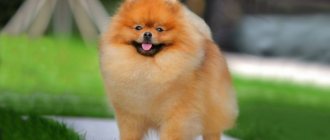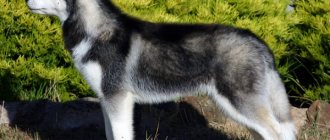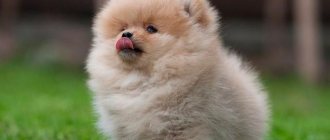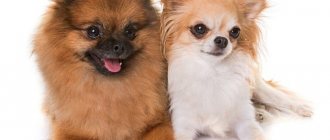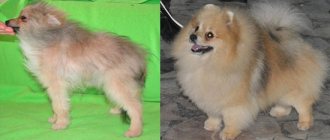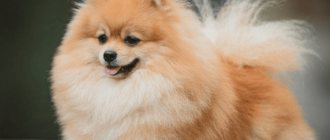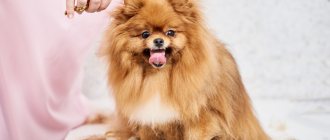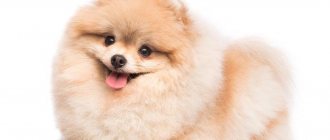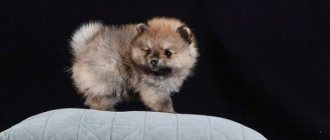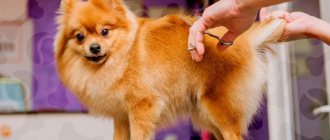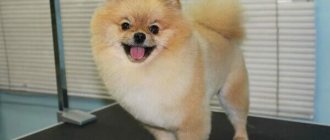According to the standard, the tail of a Pomeranian Spitz should have a straight, even structure. Typically, dogs of this breed hold it high above their back. The tip of the tail should curl. If the tail of a dwarf dog is drooping, then this is considered a defect. In this article we will tell you what can cause a Pomeranian's tail to droop.
What you should know about the Pomeranian tail.
Spitz belongs to group 5 “Spitz and primitive types of dogs”. With rare exceptions, almost all representatives of the group have a ring tail. According to the breed standard, the tail of the Pomeranian Spitz is curled into a ring; a double loop is allowed at the end of the tail. The tail is curled so tightly that it may appear stiff, but it is not. Newborn puppies have a straight tail, but at the age of about 3 months a curl in the shape of the letter “L” begins to form, by 4-5 months the tail “lies” on the back, by 7 you can see your puppy’s fully formed tail in the shape of a double ring. The bolder and more temperamental your little one is, the steeper the bend of his tail.
Healthy puppy
Puppies of the Pomeranian type differ from the classic narrow-faced ones. The orange has a short muzzle, small ears, thick undercoat, thick cheeks, a high-set tail, and thick paws. With a classic Spitz, everything is the opposite, and the coat is noticeably different - without a thick undercoat. That's why it sticks out in all directions. The Pomeranian's fur sticks out on end, his head is rounded, and in general the puppy resembles a teddy bear. Both representatives of the Pomeranian type and classic ones can be born in one litter.
Since we are talking about Pomeranians, we will consider the health of Pomeranians. Look around the nursery where you are and came to buy an orange. If it is dirty and basic sanitary standards are not observed, it is not safe for a Pomeranian to be there. The Pomeranian's thick coat requires care. Therefore, any pollution can negatively affect it. In this case, parasites on the skin breed much faster and infection with helminths is possible.
It is also important that the dog has documents - a veterinary passport and a card. You should check whether the dog is branded and how many vaccinations have been received, usually this is already two and a rabies vaccination. You will also see the date of deworming in the documents. A healthy puppy has a perky character, is affectionate and wags its tail when introduced. He is active and cheerful, but external signs will also help you find out if the puppy is sick.
Since the orange's eyes are surrounded by fluffy fur, they often water. But this is normal, after buying a puppy you need to take care of your eyes and wash them regularly. But if souring and purulent discharge are observed in the eyes, this is not good and may indicate a cold or allergy.
Small ears clean up quite well if they are looked after, but the skin on areas covered with fur is quite sensitive - check it for redness and pimples.
All almond-shaped Spitz dogs have slightly slanted eyes and a scissor bite. Pay attention to the snow-white shade of the teeth and the smell of your breath. There should be no dirt around the anus, neat claws and clean paw pads. A healthy puppy's skin is free of dandruff and irritation.
So what's up with the tail?
It is the initial “L” shaped kink at the tip of the tail that confuses owners and veterinarians. In order to avoid a crease or fracture, you should gently massage the tail with two fingers from base to tip, while pulling the tail upward (without fanaticism!). If everything is in order, then your Spitz’s tail should straighten after this manipulation. If it doesn’t straighten up, it’s most likely a fracture. It's very easy to break a puppy's tail - just step on it, pin it in a door, or pull it carelessly.
Division into classes
All Pomeranian puppies can be divided into classes depending on their show characteristics. The Pomeranian Spitz, whose puppies are so adorable, is divided into the following classes:
- Show class;
- Breeding class;
- Pett class.
If you have no idea about these classes and want a puppy for your soul, as a family pet, then the pet class of puppies will suit you.
Their cost is much cheaper, but this does not mean. That the puppy is sick. He is just as beautiful and healthy, he just has some defects according to the standard, perhaps which you will not see until they are pointed out to you. This allows us to reduce the price of such puppies, because they will not be allowed for breeding and are not allowed to go to exhibitions. But this won’t stop you from enjoying communication with an animal, right?
Show puppies look extravagant and have no bite defects, no tail set, and are evenly colored. They are allowed for exhibitions and breeding. But the breed is only bred, and they are not suitable for exhibitions. In general, you have the opportunity to choose from three price categories - from $500 to $2000, and your job is to choose the appropriate price range for your pocket.
Do the Pomeranians in the photo have straight tails?
Another popular misconception among beginning Spitz breeders is that show Pomeranians supposedly have straight tails that lie on their backs. In fact, a straight tail on a Spitz is acceptable, but normally it is a tight “donut”, and groomers can easily create the illusion of a straight tail by combing the tail hair over the back and fixing it with hairspray. Fashions for haircuts and styling change, but the tail of a Pomeranian Spitz should fit tightly to the back, although, of course, a straight tail and a sickle tail are allowed by the breed standard!
Health to you and your pets!
Author Gainulina Elena Leonidovna. Veterinarian at the nursery "from Panda Sharm".
Disqualifying faults
Any deviation from the standard is considered in the amount that determines it. Dogs that will definitely be disqualified will have:
- malocclusion;
- white spots in a single color;
- not overgrown crown;
- irregular shape of the skull;
- light eyes, nose, lips, paw pads;
- height and weight discrepancy;
- poor coordination of movements;
- problems with the reproductive organ in males.
In addition, individuals with an incomplete number of teeth, incorrect body constitution, or other deviations from the standard are sometimes considered a deviation and removed from competition. They are not recommended to be used for breeding.
In Germany there are no separate varieties of Spitz, they are all considered a single breed and have the same standards. Great Britain and America think differently; they divided Spitz into subspecies and established selection criteria for each. In fact, regardless of the Spitz's identity, its character always remains cheerful and cheerful; the dog will be a devoted friend and an excellent guard for its owner.
Temperament
The most important thing for a Spitz is its cheerfulness. He is always ready for any adventure, is happy to go for a walk and will support his owner in everything. The cheerful disposition and devotion make dogs of this breed the most preferable for friendship and protection.
Loud barking will notify you of the arrival of guests, and the joy from spending time together will be immeasurable.
A properly styled haircut looks elegant
Coat care during the renewal period
During the shedding period, Pomeranians need special coat care. Proper combing will shorten the period of active shedding of guard hairs and undercoat.
It is necessary to comb your pet during coat renewal at least once every 2 days. The procedure takes on average 15 minutes. The dog must be thoroughly combed. This will prevent the appearance of tangles.
The Spitz is combed with a special comb. After the bulk of the dead hairs and undercoat have been removed, you can use a slicker brush. Some dog owners prefer to use a furminator, which makes the procedure much easier, making it faster.
Brushing not only helps to get rid of dead hair, but also stimulates the growth of new hair by improving local blood circulation.
Features of maintenance and care
A Pomeranian Spitz dog can get along anywhere. She would be suitable for both a one-room apartment and a country house. The only thing is that you can’t place a Miniature Spitz on the street - it’s a decorative dog that needs comfort and communication with people.
In warm weather, the Pomeranian can stay during the day for several hours in a special walking enclosure. But usually the pet cannot stand loneliness; it is more interesting for him to play with a person than to keep himself occupied.
In the house, wires are first removed into cable channels, carpets are raised, shoes and clothes are hidden, fragile objects are moved higher, and cracks and holes are sealed. This way the Pomeranian Spitz puppy will not get hurt, and the owner will protect the property from the pet’s sharp and curious teeth.
Grooming
Caring for a Pomeranian Spitz is simple and easy to do yourself at home. The only procedure that requires the hand of a professional is a haircut. But it is simple: the coat of the Miniature Spitz is simply trimmed, and the owners themselves master this simple skill over time.
Grooming a Pomeranian is aimed only at giving the dog a neat appearance. You cannot cut the guard hair down to the undercoat, affecting the latter and spoiling the natural appearance.
Dwarf Spitz shed moderately, more heavily in spring and autumn. But they have a dense undercoat, thick hair that bunches up in tangles behind the ears, in the groin and between the toes. Cutting them spoils the elegant coat of Pomeranians - dogs with bald spots look ugly in person and in photographs, and they are not allowed to exhibit.
Therefore, Pomeranians are combed daily, maximum every other day. During the molting period, the fur coat is tidied up twice a day.
Otherwise, the Miniature Spitz is unpretentious. Need to:
- examine the mouth for the presence of caries, plaque, inflammation, and bleeding gums;
- brush your teeth 2-3 times a week;
- give hard vegetables and toothpick treats to remove plaque;
- trim nails every 3-4 weeks;
- remove nitrous oxide from the eyes;
- Inspect your ears weekly to remove plaque and wax from them.
Walk
Although the Mini Spitz is a decorative dog, it is not a sofa dog. He is athletic, always going for many hours of walks, games, and activities.
Therefore, they walk the Pomeranian twice a day for 1-2 hours. Immediately after going outside, the miniature spitz is allowed to relieve itself, frolic, communicate with its relatives, and then they move on to training and practicing tricks. They end the walk on a positive note – with a game.
It is not recommended to walk Pomeranians on harnesses or metal chains - they wear out the luxurious coat. The best choice is leather collars.
If your miniature Spitz is trained at home to go to the diaper or go to the toilet, you can skip walking in inclement weather.
Bathing
The Miniature Pomeranian should not be washed frequently. A protective fat layer forms on the dog's fur, which is washed away with frequent bathing. The optimal frequency of the procedure is once a month.
Miniature Spitz dogs are not bathed during shedding. Falling hairs become tangled when wet, and it is impossible to comb the fur coat.
Here's how to bathe a Pomeranian:
- pre-comb, sort out or pluck out tangles;
- plug your ears with cotton wool or sponges to prevent water from getting into them;
- completely wet the wool in the shower;
- Apply zoo shampoo diluted in water to the fur - use special rulers for long-haired dogs;
- beat the shampoo into foam, rinse thoroughly;
- use conditioner or balm if desired;
- Dry with a hairdryer at low temperatures and at the same time comb the fur.
After bathing, it is not advisable to go for a walk or leave the dog in drafts - the miniature Spitz may catch a cold.
Feeding
The dwarf spitz is a picky person. He loves treats, sweets, flour, and often refuses to eat healthy cereals and vegetables. Coupled with manipulative talent, such an attitude towards nutrition will lead to diseases of the gastrointestinal tract, blood vessels, heart, joints, and skin.
It is necessary to form correct eating habits in a Miniature Spitz from puppyhood. The easiest way is to feed your dog with ready-made holistic or super-premium food for miniature breeds. Suitable:
- Piccolo Small Dogs;
- Applaws Puppy Small & Medium;
- Acana Heritage Puppy Small Breed;
- Grandorf Adult Mini;
- Optima Nova Puppy Sensitive All Breeds.
On a natural diet, it is more difficult to balance a Spitz’s diet and calculate the optimal portion size. Plus, the miniature Pomeranian is prone to obesity, food allergies, and deficiencies in feeding are reflected in the coat. Therefore it is imperative:
- give lean cooked meat;
- exclude potential allergens - chicken, corn, wheat;
- vegetables are given stewed or boiled;
- the miniature spitz loves raw sweet fruits, but is not carried away by them;
Additionally, vitamin and mineral supplements are introduced into the orange's diet.
6. Yulia Tsareva, Rybinsk Hello! Glad to meet you! Today I want to tell you about Petrovsky Park! Anyone traveling along the Volga, passing by the ancient city of Rybinsk, will definitely pay attention to the vast park located on the left bank. At the very confluence of the Sheksna into the Volga. There, in the shady crowns, to this day rest the remains of the once very lush family estate of the Mikhalkov nobles, the ancestors of the famous writer-film family. Today, the history of this family nest, like many others, abandoned and destroyed, is almost a legend, a kind of echo of a very beautiful melody that has forever melted in the river of time. But once upon a time it sounded full and rich... At the beginning of the 18th century, representatives of the most famous families began to build their residences in the vicinity of Rybinsk. The Musins-Pushkins, Kurakins, Urusovs, Likhachevs... They came to the estates that grew near Rybinsk for the summer, and, as a rule, spent the winter in Moscow and St. Petersburg - in service and social life. The Mikhalkovs lived in a similar way, many of whose representatives occupied high positions at the courts of the Grand Dukes and Tsars of Moscow, and became famous for their faithful service to the Fatherland and enlightenment. The Mikhalkov family, which dates back to the 15th century, has been associated with Rybinsk since 1708. Then the retired warrant officer of the Moscow Military Order, Pyotr Dmitrievich Mikhalkov, married Princess Alexandra Nikitina of Ukhtomskaya and received an estate “by dowry”. And that, in turn, until the 1680s was the patrimony of the Kuzmin nobles. Allegedly in honor of Pyotr Mikhalkov, the village with the church and the estate were named Petrovskoye. However, there is another version of the name: in the 1730s, a beautiful white stone church with thrones in honor of the holy apostles Peter and Paul was built in the village. A family tomb was laid next to it. Both were destroyed after the 1917 revolution. From the right bank of the Volga, from Rybinsk, a huge manor house built during the time of Empress Anna Ioannovna is clearly visible among the greenery of the park. In the second half of the 18th century, the estate was expanded by building stone outbuildings and stables. At the beginning of the 19th century, the house was built with a second floor, and in the 20th century - with a third. One memory is connected with the Mikhalkov house, today it is more like a legend. When the famous temporary worker Biron was sent into exile in Yaroslavl, an overnight stay was appointed in the village of Petrovskoye. Having gone ashore, Biron demanded to be given the manor's house, but the former mayor, without the owner's permission, did not let Biron in. Once upon a time, an all-powerful nobleman had to spend the night in a bathhouse. FCI STANDARD No. 97 dated January 25, 2013 German Spitz, including Keeshond and PomeranianCountry of origin: Germany. Use: guard dog and companion dog. FCI Group 5: Spitz and primitive dogs (no working tests). Brief historical background: German Spitz are descendants of the Stone Age “peat dog” and are the oldest dog breed in Central Europe. They became the progenitors of many other breeds. In non-German-speaking countries, Wolfspitz are also called Keeshonds, and Miniature Spitz-Pomeranians. Comment: Keeshonds (the breed received this name in the early 20s of the last century in Holland) and Wolfspitzes developed separately from each other for quite a long time, but since they undoubtedly have a common origin, the latest FCI standard united them into one breed. The name “Pomeranian Spitz” or “Pomeranian”, adopted in England, where the miniaturization of the breed first began, America and some other countries, comes from the name of Pomerania, one of the regions of Germany. Behavior and character: The German Spitz is constantly attentive, lively and unusually attached to its owner. He is very understanding and easy to train. His distrust of strangers and his lack of hunting instinct make him an ideal home and yard guard. He is not fearful or aggressive. Weather resistance, excellent health and longevity are its outstanding qualities. General impression: Spitz dogs captivate with their beautiful, standing (due to the rich undercoat) coat. Particularly impressive is the luxurious collar around the neck and the very fluffy tail that the Spitz cheerfully carries on his back. A fox-like head with nimble eyes, sharp, small, close-set erect ears give the Spitz a characteristic perky appearance. The most important proportions: Height at the withers: oblique length of the body = 1:1
Head: Skull of medium size. When viewed from above, the head tapers wedge-shaped towards the nose. The stop is well defined, not sharp. I draw your attention to the last sentence. It is quite logical that depending on the size (from Keeshond to Pomeranian), the stop becomes more and more pronounced and is quite well expressed in Pomeranians. With the influx of American and Canadian dogs into the breed, the feet, especially in Pomeranians, have become more pronounced; I do not consider this a serious drawback of the modern miniature Spitz, except in cases where a Spitz with an overly pronounced sharp stop loses its typical expression. Preferences in head types are of course the prerogative of breeders and judges, but I think that the Small Spitz should not be an enlarged copy of the Pomeranian and has the right to its own unique appearance. A round skull, as well as a flat one, is a defect that is punished depending on the degree of severity. Muzzle: not too long, not rough, but not pointed either, is in harmonious proportion with the skull (in Wolfspitz, large and medium-sized Spitz, the ratio of the length of the muzzle to the length of the skull is approximately 2:3, in the small and miniature Spitz - 2:4) . Individuals with exaggeratedly short and overly voluminous muzzles (this trait is often combined with heavy bones) are extremely undesirable in the breed. Nose: round, small, always black (in browns it matches the color). The nose lobe may lighten slightly in orange dogs in winter, sometimes during shedding, in old dogs and in dogs of light cream color (in cream dogs the nose lobe is always lighter than in dogs of other colors), in other cases, except for brown dogs, the lobe should be black. Lips: fit tightly and do not form folds at the corners of the mouth. Pigmentation is always black (for brown dogs it matches the color). Jaws and Teeth: The jaws are normally developed and have a scissor bite with 42 teeth (some premolars may be missing in the Miniature Spitz/Pomeranian and Small Spitz). A pincer bite is acceptable in all varieties of Spitz. According to the regulations of the German Spitz Club, the score is not reduced (this applies to miniature and miniature Spitz dogs) for the absence of no more than 3 premolars from the entire set of first and second premolars. This is a German internal regulation, but not a requirement of the standard, so it is the judge's prerogative to punish a dog for missing P3 or P4. I believe that a dog with a large number of missing premolars should be downgraded. A slight “non-linear”, when some incisors can slightly (no more than the thickness of the tooth) protrude beyond the line of the correct arc, is allowed. I hope it is clear that the standard requires a full set of cutters, i.e. 6 x 6. Cheekbones: Softly rounded, not prominent. Eyes: medium size, almond-shaped, slightly slanted, dark in color. Eyelids with black pigmentation in all colors (in brown Spitz - to match the color). Disadvantages include too large and round eyes, bulging eyes, as well as dripping eyes; in case of severe smudges, the dog should be punished by a reduction in score or, in especially severe cases, by disqualification (see disqualification points - entropy and ectopia). Ears: small, set high and relatively close to each other, triangular, pointed with hard tips. Typical faults are low-set ears, wide-set ears (with an excessively wide skull), large ears. Much less common is such a defect as rounded ear tips, but grooming fashion dictates just such a shape, so the surest way to determine the true shape of the ears is a manual examination.
Neck: medium length, wide at the shoulders, slightly arched at the nape, without dewlap, covered with abundant hair in the form of a mane. Body: Topline: Starts at the tips of the erect ears and flows in a smooth arc into a short, straight back. Withers/Back: High withers blend seamlessly into the shortest possible, strong, straight back. Although an anatomically correct Spitz looks high-fronted due to the arched neck and thick mane, it should be understood that the Spitz does not have a flowing topline and this feature should not be considered desirable, because. The high anteriority of the Spitz is usually caused by the angle of the glenohumeral joint being too wide.
Loin: short, wide. Croup: wide and short, not sloping. Chest: deep, well arched, well developed breastbone. Underline: The chest is as long as possible, the stomach is moderately tucked. Tail: set high, of medium length, rises immediately from the root, thrown forward and over the back, close to the back in a tight ring, very fluffy. A double ring at the tip of the tail is allowed. Forelegs: General appearance: straight, wide front. Shoulders: Well muscled, close to the chest. The shoulder blades are long and obliquely directed back; the shoulder, almost the same length, forms an angle of approx. 90 degrees. Elbows: The elbow joint is strong, the elbows are adjacent to the chest, neither turned out nor inward. Forearms: medium length, strong, completely straight, with good feathering on the back side. Pasterns: strong, of medium length, forming an angle of 20 degrees with the vertical. Forelegs: if possible, small, round, collected, so-called. "cat's paws" The nails and pads are black, dark brown in all brown Spitz dogs.
Hindquarters: General appearance: The hindquarters are very muscular, with luxurious breeches down to the hocks. The hind limbs are straight, parallel to each other. Thigh/Shin: The thigh and shin are approximately equal in length. Knee: The knee joint is strong, the angle is moderate, and does not move either outward or inward when moving. Metatarsus: Metatarsus of medium length, very strong, set vertically to the ground. Hind feet: The feet on the hind limbs are as small as possible, round, the toes fit well together, arched, so-called. cat paws, dense pads. The color of the pads and claws may be darker. Movement: The German Spitz moves with good drive, in a straight line, free and springy. Skin: Fits tightly to the body, without forming folds. Coat: Coat: double coat - long, straight, standing outer coat and short, dense undercoat. The head, ears, front side of the fore and hind limbs, paws are covered with short and dense hair, the rest of the body is covered with long and rich hair; not wavy, not curly, not forming a parting on the back. There is a thick mane on the neck and shoulders. There are featherings on the back of the forelimbs. The hind limbs from the croup to the hocks have luxurious trousers, the tail is profusely furred. A very serious drawback can be attributed to the so-called “cotton” coat, which unfortunately began to be found in Pomeranians, with an overdeveloped undercoat (too thick and long) and sparse guard hair. In this case, the difference between the guard coat and the undercoat is practically indistinguishable. To the touch, such wool seems dry and “cotton-like,” while proper Spitz hair feels silky and elastic to the touch, but it should not be light and thin or, on the contrary, heavy. Color: Wolfspitz: wolf (Greyshaded - gray with black) Large Spitz: black, brown, white. Medium, small and miniature Spitz: black, brown, white, orange, wolf and other colors. Black color: solid deep black without white spots or other shades. Often, young black dogs experience “overcoloring” - graying on the pants and on the collar, which goes away with age, when the dog’s coat finally changes to “adult”, although light gray hair on the pants can be constantly present, which is inevitable when mating black dogs with non-black, in addition, the color of the undercoat sometimes has a grayish tint. This is often seen in other breeds, such as black Chow Chows, and is not a fault, unlike obvious grayish and reddish areas along the body, which should be considered a serious fault or a defect (depending on the severity). Brown color: uniformly uniform, dark brown. White color: pure white, without any tints. Orange color: uniformly monochromatic color in the middle scale of the color spectrum. Wolf: silver-gray with black tips of the hair, dark fur on the face and ears, around the eyes a distinct pattern of a thin black line running obliquely from the outer corner of the eye to the lower base of the ear, light mane and collar on the shoulders, black tip of the tail, lower the tip of the tail and pants are light silver in color. I would like to add a few words about some possible differences in wolf color between Keeshonds and other varieties of Spitz (medium, small and miniature). The fact is that only Keeshonds (Wolfspitz), which are bred “in themselves”, have the only standard wolf color for Wolfspitz, while breeding of smaller varieties of Spitz was not carried out in isolation (in the pedigrees of such dogs, in addition to wolf, there are other colors), therefore, their wolf color varies from light gray with black to very dark, the mask can be lightened, the characteristic pattern around the eyes is usually preserved. I think judges should take this situation into account and be sensitive to the intensity of the wolf coloring in miniature and small Spitz dogs. In the pedigrees of different countries, the wolf color is recorded as “volf” or “volf-sable” or “silver-sable”. Other colors: The term “other colors” means cream, cream-sable, orange-sable, black and tan, spotted. The main background of spotted dogs is white. Black, brown, gray or orange color spots are distributed throughout the body. Let me emphasize once again that the main tone of spotted dogs is white (pure white, without specks). Visually, the dog should look white with spots, and not vice versa, and preference should be given to dogs when the white color on the head is present in the form of a symmetrical blaze (this is a desirable feature, but not mandatory) and the colored spots are evenly distributed throughout the body. The standard does not specify the location of the spots, but in all breeds there are always unspoken preferences. Of course, this does not mean that an asymmetrical pattern on the head or a pure white color of the head are disadvantages. The colors of the spots are indicated in the standard, while the Spitz has two modifications of orange color: pure orange and orange-sable, and gray color exists only in the form of wolf, so spots, in addition to black and brown, can be either orange or orange-sable and wolf (gray with black). Disadvantages of the color are: raincoat color, excessively “whitened” color, in which there are practically no colored areas (for example, a spot only around the eye (monocle) or on the ear, or one or two small spots on the body), although I think that they are too whitened dogs should be punished to a much lesser extent than those in which the areas of depigmentation are very little pronounced and in which the dog is not essentially white with spots, but black (orange, brown or silver sable) with white spots, which is essentially vicious color. The disadvantages of a spotted color include speckling, if it is weakly expressed on the paws and face. If a dog has large speckled areas on its paws, body and face, this should also be severely punished. Dimensions: Height at withers: Wolfspitz / Keeshond 49 cm + - 6 cm Large Spitz 46 cm + - 4 cm Medium Spitz 34 cm + - 4 cm Small Spitz 26 cm + - 3 cm Miniature Spitz / Pomeranian 20 cm + - 2 cm (specimens below 18 cm is undesirable). Weight: corresponds to the height of the dog.
Faults: Any deviation from the above points should be considered a fault, and the seriousness with which the fault should be regarded should be in exact proportion to its degree of severity and effect on the health and welfare of the dog. This point applies to the evaluation of each dog's characteristics described in the standard. Those. The judge can evaluate each deficiency in different ways: from reducing the score to disqualifying the dog. Defects: - physique defects. - too flat head, apple-shaped head. - Large and medium sized Wolfspitz have dental deficiencies. - flesh-colored nose, eyelids and lips - eyes too large and too light, bulging eyes. - defects of the movement apparatus. - lack of a characteristic pattern on the face with wolf coloring. Disqualifying faults: -aggressiveness or excessive cowardice; -any dog with obvious physical or mental abnormalities must be disqualified. - not closed fontanel. I draw your attention to the fact that when a dog reaches the age at which its breeding activities are allowed (junior class), it must be disqualified for not closing the fontanel (this applies mainly to Pomeranians). I allow myself to “turn a blind eye” to a small parietal fontanel in the baby and puppy classes when it is obvious to me that this is a temporary situation, but owners and breeders should understand that the judge evaluating this situation is strictly according to the requirement of a standard that does not specify age factors breed has every right to punish the dog in accordance with this paragraph of the standard. - overshot or undershot, - ectropia and entropy, - semi-erect ears, - obvious white spots in all non-white colors, “Very small white spots on the chest and tips of the paws, which are practically invisible (not clearly expressed), can be regarded as a fault.” - any color that has a Merle factor.
Males must have two normally developed testes, fully descended into the scrotum. ———————————————————————————————
A few words about grooming a Spitz. Although grooming is not provided for by the standard, a modern show Spitz requires grooming. Grooming of a small, medium-sized Spitz and Keeshond comes down only to giving the dog a neat appearance; grooming of a Pomeranian is more susceptible to the influence of fashion and requires more time in preparing the Spitz for an exhibition. At the same time, we should not forget about the Spitz’s double coat, the natural appearance of which should not be disrupted by excessive grooming to the point where it is impossible to determine the correct coat structure.
This standard with comments was taken with the permission of Elena Vladimirovna Poplavskaya (Expert RKF - FCI, breed judge, owner of the Vesely Gnome kennel). Any use of this material is permitted only with the consent of E.V. Poplavskaya.
Character
The Zwergspitz is the embodiment of cheerfulness and love. This fluffy does not know despondency, melancholy and sadness. He is always on the move, ready for new games, discoveries, walks, and activities.
The Mini Spitz is naturally fidgety. He disturbs the owners, incites children into mischief, and exhausts other dogs, cats, birds and rodents to death. The Pomeranian never seems to get tired. Even after many hours of walking, a minute or two is enough for him to regain his strength.
The dwarf Spitz is a kind of electric broom. This cutie is like a ray of sunshine. But the character and habits of the orange also contain negative aspects.
Pomeranians are annoying. He becomes attached to his owner, does not leave his side for a second and follows the person everywhere, even to the toilet and shower. The Zwergspitz is like a two-year-old child who cannot be left alone.
Against the background of intolerance to loneliness, Pomeranians develop behavioral problems. Their main manifestation is “gibberish”. Left in an empty apartment, the dogs bark, howl and whine. It doesn’t matter how long the owner is absent, the dogs are able to howl for hours on end.
Excessive barking and anxiety are characteristics of the breed. Pomeranian Spitz vocalize for any reason: a visiting guest, a knock behind the wall, a phone call, steps in the entrance, a passing car, a flying fly - all these are serious reasons for barking in the eyes of a Miniature Spitz.
Because of their bark, Pomeranians are considered watchdogs. But this is a conditional quality. The dog actually warns with its voice about unusual events. But he does this out of fear and anxiety.
The characteristics of the breed also include the Pomeranian's tendency to manipulate. In this, Pomeranians have no equal. They are wonderful actors: they know how to portray hunger, melancholy, fear, and throw hysterics. Miniature Spitz understand how beautiful and charming they are and take advantage of it.
The Mini Spitz lives up to the saying “a small dog is always a puppy.” From birth to old age, dogs are curious, energetic, cheerful and playful. Only in the last years of life do miniature Spitz dogs partially lose their temperament.
